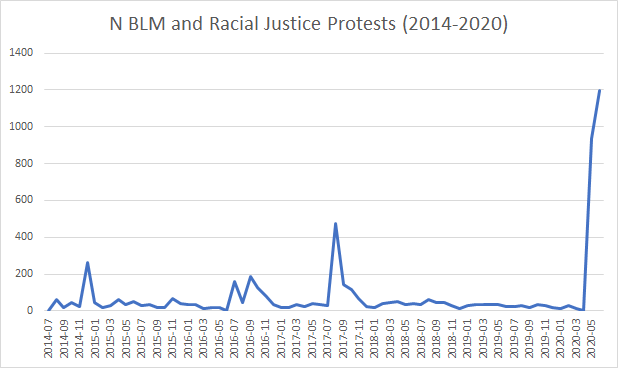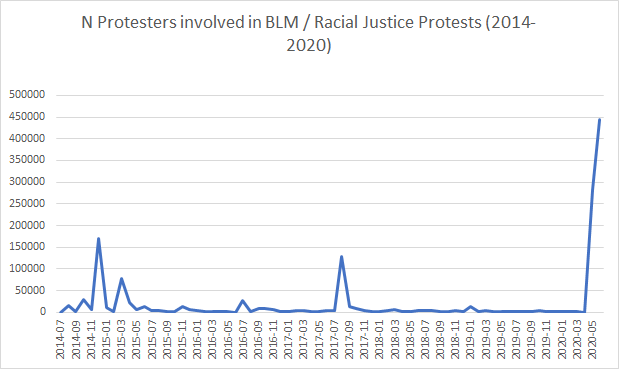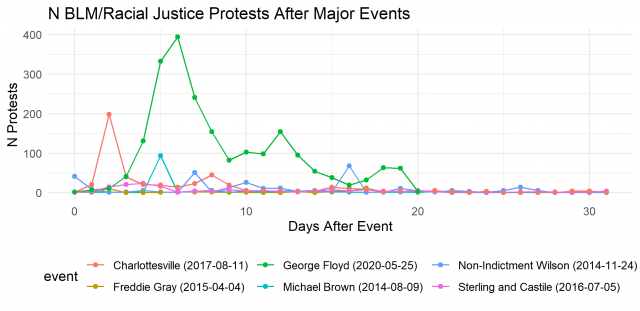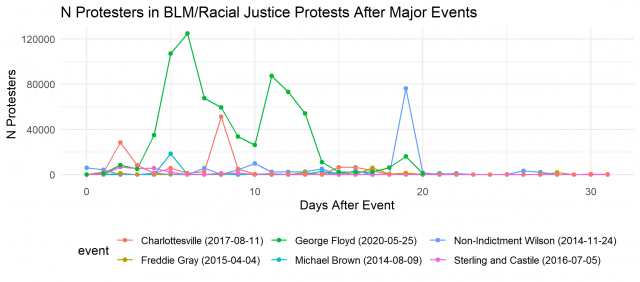Much excellent work has been written about the need for systemic reform of policing in the US, the discrimination and inequalities faced by Black Americans, and the brave struggles of anti-racist protesters amidst the ongoing police repression and the unprecedented COVID-19 global pandemic. As social movements go, the ongoing mobilizations have clearly set the political agenda of anti-racism in a news cycle previously dominated by public health policies around COVID-19. Right now, it’s far too early to tell the political and cultural consequences of the current protests, but what we do know so far from the data is that this current wave is significantly larger than previous protest waves in the past. Since it has been a couple of weeks since George Floyd’s death, we are starting to get data trickling in on the scale and size of the current anti-police brutality protests. I will focus here on presenting some preliminary statistics and figures of the current Black Lives Matter protests and compare them with previous mobilizations.
Typically, protest event data have come from newspaper articles and other news media that report on protests. While news outlets do generally provide accurate descriptions of the protests they cover, they cannot cover all cases of protest. This means that any estimates of protests are thus heavily subjected to selection bias and are undercounts (for a review, see Earl et al. 2004). Furthermore, because of the sheer size and scale of ongoing protests, current data collection efforts are lagging weeks if not days behind. Consequently, this means that any estimates I will present here are inevitably underestimates of the actual number of protesters and those participating in them. Nonetheless, I still think a comparison is useful to get a sense of the how large these current protests are compared to previous ones.
More detailed figures and description of data are shown below, but here are the two major findings of the data I had available on hand:
- In the two weeks since George Floyd’s death (May 25th 2020), around 694,315 protesters participated in 1900 protests according to the Count Love Blog, with events still being counted.
- These protests are significantly larger than previous protest waves. When comparing counts of protests and protesters across two-week periods, the current protest wave has 4.5 times as many protests and 6.3 times as many protesters as the anti-racist protests against the “Unite the Right” rally in Charlottesville (Aug 2017) and 10.4 times as many protests and 15.2 times as many protesters as the largest BLM protest wave around the non-indictments of police officers Darren Wilson and Daniel Pantaleo (Nov/Dec 2014). The latter two were previously the largest since this current one.
Data Sources
My results come from three main data sources. The first comes from an article by Vanessa Williamson, Kris-Stella Trump (no relation), and Katherine Einstein (2018) who collected Black Lives Matter protest data in one year between August 9th 2014 to August 9th 2015 to study the extent that Black deaths by police predicted protest activity. The second source comes from Alisa Robinson, a resident of Chicago who runs the website Elephrame. She has been collecting information about Black Lives Matter protests from news sources, social media, and social movement organizations since the Ferguson protests in August 2014. I will use this data to substitute counts between August 10th 2015 to January 15th 2017. Finally, the data for current Black Lives Matter protests comes from the Count Love blog run by two data scientists Tommy Leung and Nathan Perkins. They aggregate protest data by crawling over 1600 local news outlets and employ a combination of natural-language processing tools and manual human coding to track protests as they arise (see Fisher et al. 2019 for further description of methodology). They have run this blog since the Women’s Marches in 2017 protesting President Trump’s inauguration. Working with these multiple data sources does mean that I’m can’t fully rule out that differences across these time periods are due to data collection methodologies or actual events. Still, you can see from the results below that differences are large enough where these methodological concerns probably don’t matter much.
Results
The first two figures present a time-series trend of monthly counts of BLM and racial justice protests and number of protesters involved between 2014 and 2020. They show an unprecedented increase of protest events and protesters in May and June 2020 months compared to all other periods. As you can see, the current protests immensely dwarf other national protest waves following important events such as the death of Michael Brown (August 2014), the non-indictments of Darren Wilson (November 2014) and Daniel Pantaleo (December 2014), the deaths of Alton Sterling and Philando Castile (July 2016) and the protests against the Unite the Right rally in Charlottesville (August 2017).


The next two figures depict a more direct comparison of number of protests and protesters involved in the days since each major event. They show similar conclusions as stated above.


Summary Statistics on Two Weeks after each Event:
- Michael Brown’s death (Aug 9th 2014):
- 25,094 protesters in 131 protests (Williamson et al. 2018)
- Non-Indictment of Darren Wilson (Nov 24th 2014) / Daniel Pantaleo (Dec 3rd 2014):
- 45,602 in 183 protests (Williamson et al. 2018)
- Freddie Gray’s arrest (April 12th 2015):
- 5,007 protesters in 24 protests (Williamson et al. 2018)
- Death of Alton Sterling & Philando Castile (July 5/7th 2016):
- 26,054 protesters in 118 protests (Elephrame)
- Charlottesville “United the Right” Rally (Aug 11th 2017):
- 109,608 protesters in 424 protests (Count Love)
- George Floyd’s death (May 25 2020):
- 694,315 protesters in 1,900 protests, with protests still being counted (Count Love)
References
Fisher, Dana R., Kenneth T. Andrews, Neal Caren, Erica Chenoweth, Michael T. Heaney, Tommy Leung, L. Nathan Perkins, and Jeremy Pressman. 2019. “The Science of Contemporary Street Protest: New Efforts in the United States.” Science Advances 5(10):eaaw5461.
Earl, Jennifer, Andrew Martin, John D. McCarthy, and Sarah A. Soule. 2004. “The Use of Newspaper Data in the Study of Collective Action.” Annual Review of Sociology 30:65–80.
Leung, Tommy and Nathan Perkins. Count Love Blog. Retrieved from: https://countlove.org/
Robinson, Alisa. List of Black Lives Matter Demonstrations. Retrieved from: https://elephrame.com/textbook/BLM/chart
Williamson, Vanessa, Kris-Stella Trump, and Katherine Levine Einstein. 2018. “Black Lives Matter: Evidence That Police-Caused Deaths Predict Protest Activity.” Perspectives on Politics 16(2):400–415. Data found here: https://dataverse.harvard.edu/dataset.xhtml?persistentId=doi:10.7910/DVN/L2GSK6&version=1.0
Todd Lu is a PhD student in the Department of Sociology at UNC Chapel Hill. His research interests are in social movements, media, and race/ethnicity. For any inquiries, you can contact him at toddjlu@live.unc.edu.
